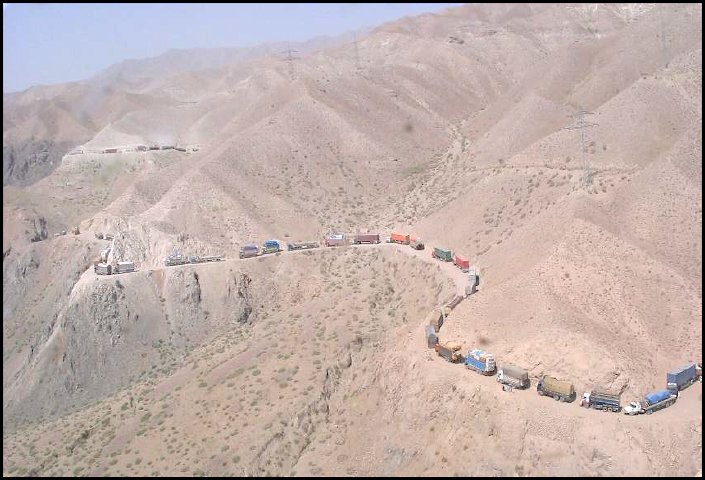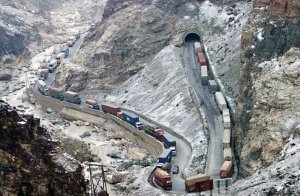Delivering to Contingency Locations Not a Smooth Road

Neither goat paths nor rugged mountain tunnels can keep the Exchange’s logistics, merchandising leaders and store managers in Southwest Asia and the Middle East from mastering patience and perseverance in getting merchandise to the Nation’s troops in contingency locations.
“You can’t plan for consistency like you can in the U.S, because in contingency locations, there is no norm,” said Morgan Meeks, the Logistics Directorate’s director of transportation operations. “With constant communication with the Merchandising Directorate and our store associates over there, we can tweak the replenishment process to ensure enough merchandise is in the pipeline to offset delays.”
Goods from throughout the world
Getting goods to Afghanistan from the Dan Daniel Distribution Center 7,000 miles away in Virginia takes 94 days, compared to 121 days last year. Getting products to Soldiers and Airmen serving in Iraq requires 61 days from Dan Daniel.
“You can’t plan for consistency like you can in the U.S, because in contingency locations, there is no norm.”
– Morgan Meeks, director of transportation operations
The Exchange, which also ships goods to contingency locations from Germany’s Germersheim Distribution Center and smokeless tobacco from Korea DC, works with the Department of Defense’s U.S. Transportation Command to line up commercial carriers.

A winding route in Afghanistan near the border with Pakistan.
Problems not as bad as the war years
During the heights of Operation Enduring Freedom and Operation Iraqi Freedom, the Exchange tracked 1,500 containers per week into contingency locations. As that number has decreased to 300, some of the delays caused by a congested infrastructure have been alleviated. Still, getting merchandise to customers in these locations isn’t smooth sailing.
Understandably, military cargo takes priority over Exchange merchandise, but the Logistics team works cooperatively to ensure containers are moving as quickly as possible on the next train or convoy.
“Anything that comes in for the military goes ahead of you on the train, for example, you get bumped and must wait for the next train,” said Richard Silvis, a Logistics Directorate senior transportation analyst. “But when the next train comes, you’re bumped again because of your low priority, then you’re delayed for a third train.”
Religious observances and delays
Other issues are caused by widely varying documentation requirements of each country. Saudi Arabia forbids hydrogen peroxide, a common antiseptic used around the world, because government officials consider it a hazardous material. Uzbekistan officials unexpectedly wanted to inspect the material data sheet to see if Vicks VapoRub contained hazardous materials.
Offices that handle clearances and other transportation documents close for Muslim religious observances, such as Ramadan, which further delays shipments. High winds often force ships bearing Exchange containers to stay at sea, while torrential rains and blinding sandstorms or even snowstorms can bring transportation to a screeching halt.
Embargoes against countries force the Exchange to completely alter air and sea routes, further extending delays.
“Then, you have your war zones and requirements for security escorts,” said Silvis, who wrestled with transportation issues during his two deployments to Southwest Asia. “Sometimes, you just have to adjust based on availability of security experts.”
Checkpoints, unexpected fees
Traveling through Afghanistan requires going through multiple checkpoints, where convoys may sit for weeks waiting for security officers. Trucks traversing through central Afghanistan’s warlord-controlled sections undergo mandatory inspections, which often require drivers to pay fees.
Some northern Afghanistan roads are nothing more than glorified goat paths. Mountain tunnels are highly susceptible to cave-ins, snow slides and avalanches, including the Salang Pass, a major route into the country, that could close with no known date of reopening. Such problems cause Exchange logistics leaders to fly merchandise into the country.
Getting into Iraq the Kuwait way
As for Iraq, the Exchange is limited to one route into Iraq and even that isn’t direct. With multiple levels of diplomatic clearances and approvals, delivering directly into Iraq isn’t practical, so all shipments wind up next door in Kuwait.
“In Kuwait, these shipments are loaded off commercial containers, broken down and reloaded into government-owned containers,” Silvis said. “Then, we work to get these container added to a convoy for delivery to Iraq.”

